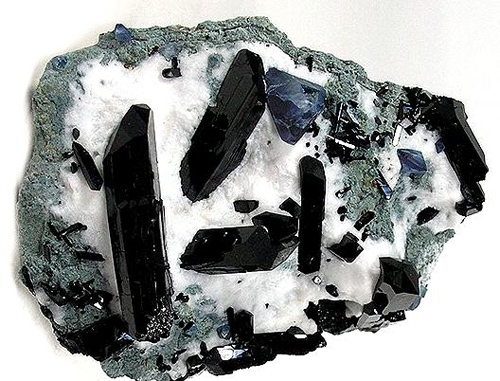The Mineral neptunite

Neptunite is a relatively recent mineral, having been first discovered only in the early 1900's. It is named after Neptunus, the Roman god of the sea, and its etymology is derived from its similarity to Aegrine, which was named after the Norse sea god. Neptunite forms a solid solution series with Manganoneptunite, which is the manganese-dominant variant of Neptunite, whereas Neptunite is the iron-dominant member.
Much of the Neptunite crystals from San Benito Co., California are deeply embedded in thick Natrolite; such specimens are prepared for collectors by dissolving the surrounding Natrolite in acid to expose the Neptunite crystals. The typical sharp contrast between black Neptunite on a white Natrolite matrix makes a very aesthetic mineral specimen. Benoite, a rare mineral associated with this locality, may also be present with the Neptunite, creating a very desirable and classic mineral combination.
Chemical Formula
KNa2Li(Mn,Fe2+)2Ti2Si8O24
Color
Visually black, with very dark maroon highlights visible on some edges or in backlighting. Also dark rusty brown to dark brownish-red.
Crystal System
Monoclinic
Crystal Habits
As sharply-formed, prismatic crystals with a square cross-section and distinct, pointed termination. Crystals sometimes intersect on an angle, and they may be doubly terminated. Occasionally also in thin, tabular crystals and in columnar aggregates.
Uses
Neptunite is primary a collectors mineral, with well-shaped, lustrous crystals highly desired by collectors.
Noteworthy Localities
By far the most significant locality for Neptunite is in the Diablo Range, near the headwaters of the San Benito River, in San Benito Co., California. Virtually all collectors specimens for this mineral are from this area. The Dallas Gem Mine in the Diablo Range is especially noted for its highly lustrous crystals associated with the rare mineral Benitoite. Lesser-known localities for Neptunite include the nepheline syenite deposits of Narsarssuk Greenland; the Kola Peninsula, Russia; and Mont Saint Hilaire, Quebec, Canada (though mostly Manganoneptunite.
Common Mineral Associations
Natrolite, Benitoite, Serpentine, Albite, Glaucophane
Distingushing Similar Minerals
Aegirine and Arfvedsonite - Can be difficult to distinguish outside of the San Benito occurrence, though it has different cleavage angles.
Hornblende - Different crystal habits (lacks typical termination), and different cleavage angles.
Schorl - Different crystal habits (lacks typical termination), different cleavage angles, and greater hardness.